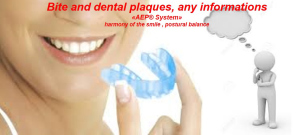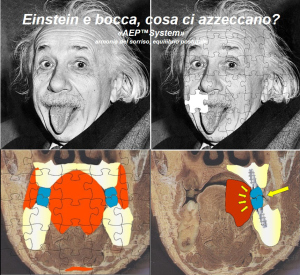The use of plates and bites, has the purpose of modifying the mandibular position when it is pathological; that is, when the mouth is closed, the teeth constrain the jaw and jaw between them, triggering muscular / articular tensions or pains in the mouth or the rest of the body.
BITE AND PLATES ARE GENERIC TERMS, the term bite derives from English bite and it is used for non-smooth devices that give a stable position and bound to the jaw, while the term plaque, is used for smooth devices that do not give a position constrained to the mandible.
There may be differences then in relation to:
• position: on the jaw or on the jaw,
• material: rigid, soft, mixed …
• approach: gnathological, gnathological-postural,
• objectives: to give a therapeutic position, to reset the position, to stabilize the position, …….
• mode of use: nighttime, daytime, ….
• optimization techniques for patient application: in regulation, in the number of appointments, …………
Plate and bite example:
The AEP® System night-time reset plate is a smooth, superior or inferior plate, made of soft / rigid material, with a gnathological / postural or gnathological approach. It is regulated by the doctor every three weeks, swallowing and voluntary closure for about 4/6 months.
THE LOGIC OF USE DERIVES FROM THE HOLISTIC VISION, ie the evidence that the human system interacts between its parts and therefore the mouth can influence and be influenced by the rest of the body. Following this consideration, the dental bond is removed with the interposition of the plate between the jaw and mandible, leaving the body free to express its ability to self-regulate by researching the physiology.
The nocturnal plaque thus resets the pathological mandibular position with the passing of the hours, therefore upon awakening, the resting position (with a half-open mouth) is physiological. The position of the teeth, however, remains unchanged and when you close the mouth after removing the plate, you initially feel abnormal contacts, but after a period of muscle adaptation of about 10/15 minutes (the time to have breakfast), apparently everything is like before.
So why is the patient well?
Because if there are no problems outside the mouth, the muscles during the night could relax and load the “energy stack”.
However, when the patient closes his mouth during the day (in physiology we do it for about 20 minutes a day during the swallowing), the dental bond slowly brings him back to the pathology situation, but the use of the “pile” loaded during the night, allows him to keep the painful silence silent until the evening when he removes the plaque.
If the patient wants to test a definitive solution, he proceeds to stabilize the mandibular position obtained upon awakening with a diurnal reprogramming bite.
The AEP® System daytime reprogramming bite is a non-smooth plate with minimum bulk volume, lower or upper, made of rigid material, with a gnathological / postural or gnathological approach. It is regulated by the doctor every three weeks in swallowing and voluntary closure for about 2/3 months.
THE USE OF THE BITE DIURNAL HAS AS A TARGET, the binding between their jaw and jaw in the new mandibular position, in order to be able to test in a stable but temporary way, the recovery of the physiology of the mouth and body.
The therapeutic path is so far reversible, if the patient is satisfied with the degree of health and well-being achieved, he definitively stabilizes the situation by acting prosthetically, orthodontically, or ….
“AEP® System” harmony of the smile, postural balance.

